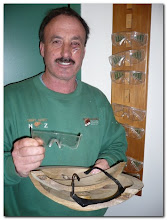 THE BURL TREE
THE BURL TREEI think the burl branch is red beech, but
I am not sure. The plan was simple -
make each of the eight burrs into a
small bowl and leave them still attached
to the tree. The operation was not so
simple.
The work is mounted onto what I call
the slide and this is moved around on
the MDF flywheel which is attached to
a 150mm face plate. I levelled and
secured the wood into the position I
required with the aid of wedges and hot
melt glue. The straps are an extra
precaution. The whole device is then
balanced with strategically placed
lumps of lead securely attached.
For each of the eight bowls the log was
re-attached and re-balanced. On
occasions I had difficulty getting the chisel down between two burls and
changes of shape were needed. When I came to do the burl on the bottom
end I didn’t have enough swing and had to cut 100mm off the other end.
The ninth bowl on the very top was turned last between centres. Some
carving was then needed to blend the cuts between bowls and restore
shape to the slimmed down branch. Airbrushing highlighted the texture
on the tree.
The burl which serves as the base was scribed around the base of the burl
tree. As this piece stands 600mm high it needed something to give it
stability.
Please note that attempting a piece like this can be rather daunting unless
you understand how to balance the work. My lathe weighs 650kg and is
bolted to the floor. This helps, but if any vibration is felt, you haven’t
spent enough time getting it balanced.
Oh, by the way, on the Monday I had to go and buy some more trailer
tie-downs as they were a bit short after this exercise. I am proud to say
this piece now sits alongside 250 others in a private collection in Hong.
Go To I think the burl branch is red beech, but
I am not sure. The plan was simple -
make each of the eight burrs into a
small bowl and leave them still attached
to the tree. The operation was not so
simple.
The work is mounted onto what I call
the slide and this is moved around on
the MDF flywheel which is attached to
a 150mm face plate. I levelled and
secured the wood into the position I
required with the aid of wedges and hot
melt glue. The straps are an extra
precaution. The whole device is then
balanced with strategically placed
lumps of lead securely attached.
For each of the eight bowls the log was
re-attached and re-balanced. On
occasions I had difficulty getting the chisel down between two burls and
changes of shape were needed. When I came to do the burl on the bottom
end I didn’t have enough swing and had to cut 100mm off the other end.
The ninth bowl on the very top was turned last between centres. Some
carving was then needed to blend the cuts between bowls and restore
shape to the slimmed down branch. Airbrushing highlighted the texture
on the tree.
The burl which serves as the base was scribed around the base of the burl
tree. As this piece stands 600mm high it needed something to give it
stability.
Please note that attempting a piece like this can be rather daunting unless
you understand how to balance the work. My lathe weighs 650kg and is
bolted to the floor. This helps, but if any vibration is felt, you haven’t
spent enough time getting it balanced.
Oh, by the way, on the Monday I had to go and buy some more trailer
tie-downs as they were a bit short after this exercise. I am proud to say
this piece now sits alongside 250 others in a private collection in Hong.
See http://www.timberly.co.nz/terry_articles.htm
For pictures of how I held this piece on the lathe

No comments:
Post a Comment